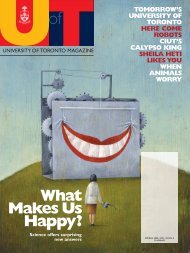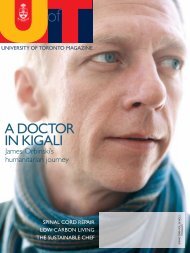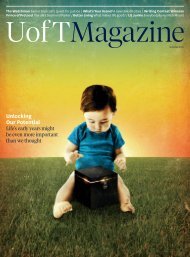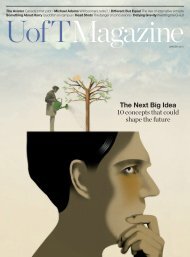What's the solution to Toronto's traffic problems? - University of ...
What's the solution to Toronto's traffic problems? - University of ...
What's the solution to Toronto's traffic problems? - University of ...
You also want an ePaper? Increase the reach of your titles
YUMPU automatically turns print PDFs into web optimized ePapers that Google loves.
Leading Edge<br />
Around 500 BCE, <strong>the</strong> ancient Greek his<strong>to</strong>rian Herodotus wrote<br />
<strong>of</strong> a prisoner who escaped from his chains by cutting <strong>of</strong>f his<br />
foot, which he later replaced with a wooden substitute<br />
PROTOTYPE<br />
The $100<br />
Artificial Leg<br />
The simple, inexpensive<br />
device matches <strong>the</strong><br />
function <strong>of</strong> far more<br />
costly technology<br />
Pr<strong>of</strong>.<br />
Jan Andrysek<br />
FOR MOST PEOPLE, THE CHEAPEST WAY <strong>to</strong> get from<br />
here <strong>to</strong> <strong>the</strong>re is <strong>to</strong> walk. But for millions<br />
around <strong>the</strong> world who have lost a leg, a highquality<br />
pros<strong>the</strong>tic limb costs more than <strong>the</strong>y<br />
can afford. The ability <strong>to</strong> walk is simply out <strong>of</strong><br />
<strong>the</strong>ir price range.<br />
This situation is changing, though, thanks<br />
<strong>to</strong> a pro<strong>to</strong>type for a low-cost pros<strong>the</strong>sis that<br />
not only matches <strong>the</strong> functions <strong>of</strong> more expensive<br />
technologies, but also is more robust and<br />
versatile.<br />
The leg’s developer, Jan Andrysek, is a<br />
pr<strong>of</strong>essor at <strong>the</strong> Institute <strong>of</strong> Biomaterials and<br />
Biomedical Engineering. While current state<strong>of</strong>-<strong>the</strong>-art<br />
limbs cost more than $3,000,<br />
Andrysek predicts his will cost $100 or even<br />
less when it goes in<strong>to</strong> widespread production.<br />
His innovation is a patented knee-joint mechanism<br />
that au<strong>to</strong>matically locks when <strong>the</strong> owner<br />
rests weight on it, and unlocks with forward<br />
movement. It acts much like a biological knee.<br />
This simple, inexpensive device matches<br />
many <strong>of</strong> <strong>the</strong> functionalities <strong>of</strong> high-end limbs<br />
that are packed with hydraulics, robotics and<br />
o<strong>the</strong>r costly technologies.<br />
“There’s always an engineering <strong>solution</strong><br />
<strong>to</strong> a technical problem if you make it complex<br />
enough,” Andrysek says. “But <strong>the</strong>re are millions<br />
<strong>of</strong> people in low- and medium-income<br />
countries, and <strong>the</strong> technologies that are accessible <strong>to</strong> <strong>the</strong>m haven’t really changed<br />
much over <strong>the</strong> last 50 years. So why not look <strong>to</strong> see if we can improve <strong>the</strong> simple technologies<br />
as well”<br />
Simplicity not only makes <strong>the</strong> pros<strong>the</strong>sis more affordable, it also makes it more<br />
versatile. Andrysek’s technology can wea<strong>the</strong>r <strong>the</strong> elements in ways existing limbs<br />
cannot. He is working with <strong>the</strong> International Committee <strong>of</strong> <strong>the</strong> Red Cross <strong>to</strong> test <strong>the</strong><br />
leg in several countries, including Tanzania and Chile, but he also sees a market for<br />
his invention in wealthier countries.<br />
“[In developed nations] people usually get <strong>the</strong>ir primary pros<strong>the</strong>sis funded. But<br />
if <strong>the</strong>y need a secondary one, <strong>the</strong>n it’s out <strong>of</strong> <strong>the</strong>ir own pocket,” he says. “And you may<br />
need a secondary leg for activities where your leg gets wet or dirty. The technologies<br />
that are out <strong>the</strong>re don’t do very well under those circumstances. Our technology<br />
is designed <strong>to</strong> be quite robust in water and dirt. There is a potential application as a<br />
‘recreational leg’ that many amputees can use.”<br />
Nobody takes <strong>to</strong> water and dirt more than children, and<br />
Andrysek believes <strong>the</strong> technology could be adapted for <strong>the</strong>m as<br />
Andrysek believes<br />
<strong>the</strong> technology<br />
could be adapted<br />
for children as well<br />
well. “It’s a bit <strong>of</strong> work <strong>to</strong> miniaturize <strong>the</strong> mechanism,” he says.<br />
“But <strong>the</strong> pediatric focus is definitely a direction we’re taking. It’s<br />
a need we’ve identified – <strong>to</strong> have a stable little knee that <strong>the</strong> kids<br />
don’t have <strong>to</strong> worry about destroying so easily. They can get it<br />
wet in a puddle and not worry about it.” – PATCHEN BARSS<br />
Findings<br />
Rehab Robot<br />
An intelligent, affordable table<strong>to</strong>p<br />
robot, designed by Alex Mihailidis <strong>of</strong><br />
occupational science and occupational<br />
<strong>the</strong>rapy, will help stroke patients continue<br />
rehabilitation at home. Mihailidis<br />
knows <strong>the</strong> speed and intensity at which<br />
stroke patients begin rehabilitation<br />
exercises greatly increases <strong>the</strong> brain’s<br />
ability <strong>to</strong> heal. But patients <strong>of</strong>ten<br />
neglect rehab exercises at home,<br />
ei<strong>the</strong>r because those exercises are<br />
boring or because attendants and<br />
rehab machines are needed <strong>to</strong> oversee<br />
<strong>the</strong> exercises.<br />
With his research team, Mihailidis<br />
designed a robot that costs about onetenth<br />
<strong>of</strong> <strong>the</strong> rehab robots currently<br />
available. It learns about <strong>the</strong> user,<br />
adapts its exercises accordingly and<br />
tracks a patient’s progress. It adjusts<br />
<strong>the</strong> difficulty <strong>of</strong> <strong>the</strong> exercises according<br />
<strong>to</strong> <strong>the</strong> user’s needs and fatigue<br />
level, while a camera system – also a<br />
unique characteristic – records <strong>the</strong><br />
patient’s posture and movements.<br />
Mihailidis hopes <strong>to</strong> distribute <strong>the</strong><br />
robot by early autumn. – ERIN VOLLICK<br />
First Light<br />
Humans used fire 300,000 years earlier<br />
than previous thought, according <strong>to</strong><br />
a research team led by U <strong>of</strong> T, Bos<strong>to</strong>n<br />
<strong>University</strong> and Hebrew <strong>University</strong>. The<br />
team found microscopic traces <strong>of</strong> wood<br />
ash alongside animal bones and s<strong>to</strong>ne<br />
<strong>to</strong>ols in a layer <strong>of</strong> excavation dated <strong>to</strong><br />
one million years ago at <strong>the</strong> Wonderwerk<br />
Cave in South Africa.<br />
Analysis <strong>of</strong> sediment revealed ash<br />
plant remains and charred bone fragments,<br />
both <strong>of</strong> which appear <strong>to</strong> have<br />
been burned locally ra<strong>the</strong>r than carried<br />
in<strong>to</strong> <strong>the</strong> cave by wind or water.<br />
“The control <strong>of</strong> fire would have been<br />
a major turning point in human evolution,”<br />
said Michael Chazan, a U <strong>of</strong> T<br />
anthropologist and co-direc<strong>to</strong>r <strong>of</strong> <strong>the</strong><br />
project. “Socializing around a campfire<br />
might be an essential aspect <strong>of</strong> what<br />
makes us human.” – KIM LUKE<br />
22 www.magazine.u<strong>to</strong>ron<strong>to</strong>.ca<br />
PHOTO: RICK EGLINTON/GETSTOCK.COM

















